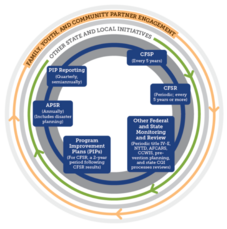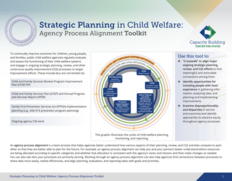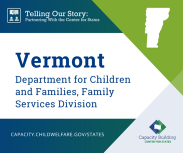
The Child and Family Services Review (CFSR) is not a standalone event. The Children’s Bureau (CB) encourages states to take an integrated approach that builds on data exploration and findings from other monitoring, reporting, and planning efforts to improve outcomes for children, young people, and families.
Improvement is a cycle and CFSR Round 4 offers an opportunity to build on other federal monitoring and improvement processes like the 5-year Child and Family Services Plan (CFSP) and Round 3 CFSR Program Improvement Plans, while aligning with other state efforts to engage in continuous quality improvement (CQI) and integrate the voices and perspectives of young people and families served by the child welfare agency.1
Below are a few tips to remember as your child welfare agency progresses through improvement cycles.
|
Tips for Aligning Improvement Efforts
-
Learn from past cycles and recent assessments. The CFSP and previous improvement efforts can provide knowledge to states and help inform their strategic planning. By reflecting on past efforts, implementation successes or challenges, and recent self-assessments, agencies will better understand what they are doing well, where they have room to improve, and what interventions might work best to bridge these gaps.
-
Build on engagement lessons and best practices. Agency teams should intentionally engage lived experts throughout improvement cycles and work to embed youth and families with lived experience at all agency levels. Agencies should learn from past efforts to engage lived expertise and ensure agency staff are adequately trained and prepared to collaborate and share power with lived experts. Agencies should have clearly defined roles and expectations within their teams and be transparent with lived experts on how their insights will be used in improvement efforts.2 It is important to avoid relying on the same people or voices or only engaging those with more “professionalized” backgrounds. Ensure your agency engages those with more recent experience and is prepared to receive honest feedback.
-
Establish information feedback loops and be mindful of agency language to ensure common understanding with communities being served. Agencies will need to intentionally gather and share information across initiatives and improvement cycles and put feedback loops in place with the communities they serve. For lived experience engagement to be effective, agencies need to be considerate of their use of jargon, alienating language, and other bureaucratic practices that might deter understanding or involvement among young adults, families, and other relevant partners. Agencies should collaborate with families and lived experts to develop a shared language and work to understand how young people and families discuss—and are most comfortable sharing—their experiences.
-
Anticipate agency capacity and needed skills. States should assess and work to grow the technical and adaptive skills they may need to learn or improve across initiatives, such as engaging those with lived experience, developing best practices in data exploration, and other programs (e.g., title IV-E prevention) that may be relevant to child welfare outcomes. It is also vital for agencies to be realistic and resourceful when assessing agency capacity and technical skills. Agencies should network across improvement initiatives to share skills and expertise and connect teams with others who have established relationships or experience engaging young people, families, and the communities both serve.
 Capacity Building Center for States (2022). Strategic planning in child welfare: Integrating efforts for systems improvement. Children’s Bureau, Administration for Children and Families, U.S. Department of Health and Human Services.

The Center has a new Agency Process Alignment Toolkit that can help agency leaders and managers find useful points of connection between major ongoing strategic planning, review, and CQI efforts. Use this toolkit to align your planning processes, find efficiencies, and generate ideas to move agency work forward.
The toolkit is one of several resources in our Strategic Planning in Child Welfare series.
|
What Does Partnership With the Center Look Like?

Learn how the Vermont Department for Children and Families, Family Services Division partnered with the Center to prepare for its Statewide Assessment and build a foundation of support for its CFSR Round 4 strategic planning efforts. The Center provided targeted support with meeting coordination, data analysis and visualization, engagement of people with lived experience, and more.
|
The Center offers resources to help child welfare agencies strategically plan and prepare for CFSR Round 4 by thinking through and building on progress and lessons learned from other planning, reporting, and program improvement efforts.
Center Resources

Resource Collection
-
CFSR Information Portal: Explore tools and resources on the entire CFSR process including Children’s Bureau guidance and announcements, state-specific CFSR information, e-learning opportunities, and more.
|
Related Resources
Did you receive this message from a friend? Get it delivered to your inbox.
|